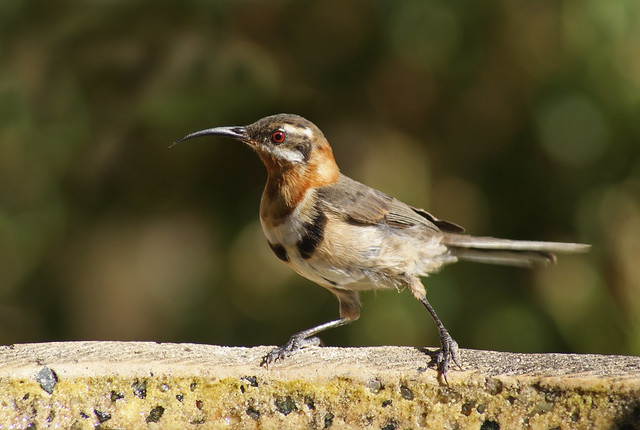Acanthorhynchus superciliosus
Superregnum: Eukaryota
Regnum: Animalia
Subregnum: Eumetazoa
Cladus: Bilateria
Cladus: Nephrozoa
Superphylum: Deuterostomia
Phylum: Chordata
Subphylum: Vertebrata
Infraphylum: Gnathostomata
Megaclassis: Osteichthyes
Cladus: Sarcopterygii
Cladus: Rhipidistia
Cladus: Tetrapodomorpha
Cladus: Eotetrapodiformes
Cladus: Elpistostegalia
Superclassis: Tetrapoda
Cladus: Reptiliomorpha
Cladus: Amniota
Classis: Reptilia
Cladus: Eureptilia
Cladus: Romeriida
Subclassis: Diapsida
Cladus: Sauria
Infraclassis: Archosauromorpha
Cladus: Crurotarsi
Divisio: Archosauria
Cladus: Avemetatarsalia
Cladus: Ornithodira
Subtaxon: Dinosauromorpha
Cladus: Dinosauriformes
Cladus: Dracohors
Cladus: Dinosauria
Ordo: Saurischia
Cladus: Eusaurischia
Cladus: Theropoda
Cladus: Neotheropoda
Cladus: Averostra
Cladus: Tetanurae
Cladus: Avetheropoda
Cladus: Coelurosauria
Cladus: Tyrannoraptora
Cladus: Maniraptoromorpha
Cladus: Maniraptoriformes
Cladus: Maniraptora
Cladus: Pennaraptora
Cladus: Paraves
Cladus: Eumaniraptora
Cladus: Avialae
Infraclassis: Aves
Cladus: Euavialae
Cladus: Avebrevicauda
Cladus: Pygostylia
Cladus: Ornithothoraces
Cladus: Euornithes
Cladus: Ornithuromorpha
Cladus: Ornithurae
Cladus: Carinatae
Parvclassis: Neornithes
Cohors: Neognathae
Cladus: Neoaves
Cladus: Telluraves
Cladus: Australaves
Ordo: Passeriformes
Subordo: Passeri
Parvordo: Corvida
Superfamilia: Meliphagoidea
Familia: Meliphagidae
Genus: Acanthorhynchus
Species: Acanthorhynchus superciliosus
Name
Acanthorhynchus superciliosus Gould, 1837
References
A synopsis of the birds of Australia, and the adjacent islands. pt2 pl.27 fig.1
Vernacular names
English: Western Spinebill
-------
The Western Spinebill, Acanthorhynchus superciliosus, is a honeyeater found in the heath and woodland of south-western Western Australia. It ranges between 12–15 centimetres (4.7–5.9 in) long,[2] and weighs around 10 grams (0.35 oz). It has a black head, gray back and wings, with a red band behind its neck and from its throat to its breast. There are white banks behind its bill and its eyes. It has a long slender curved bill.
Its contact call is a rapid high-pitched whistle, but when feeding it has a quieter whistle.
Like other honeyeaters, the Western Spinebill feeds on nectar. It tends to obtain its nectar from lower shrubs than most other honeyeaters, including Banksia, Dryandra, Grevillea, Adenanthos and Verticordia.[3] It also feeds from trees of Banksia and Eucalyptus, and from herbs such as Anigozanthos. In addition to nectar, it feeds on insects that it captures in the air or on plants.
It is a frequent visitor to Adenanthos obovatus, and its territories are smaller when they contain more Adenanthos obovatus bushes. Male spinebills often contest their territory borders with other males, and allow females to live within them. These territories range from 0.2 to 0.5 hectares in size. With their long curved bills, Western Spinebills are the only honeyeaters able to gain nectar out of the tube-like flowers.[4]
It breeds from September to January, in a nest made from bark, plant stems, down and spider web.[2] It lays 1–2 eggs,[2] usually incubated by the female.
According to early Australian settler George Fletcher Moore, the region's aboriginal people (the Noongar) called this species Buljit.[5]
References
1. ^ BirdLife International (2008). Acanthorhynchus superciliosus. In: IUCN 2008. IUCN Red List of Threatened Species. Downloaded on 19 February 2009.
2. ^ a b c Pizzey, Graham; Knight, Frank (1998). Birds of Australia. London: HarperCollins. p. 396. ISBN 0002201321.
3. ^ George (Berndt), Elizabeth A.; Margaret Pieroni (illustrations) (2002). Verticordia: the turner of hearts. Crawley: University of Western Australia Press. p. 17. ISBN 1 876 268 46 8. "In WA ... Western Spinebill (Acanthorhynchus superciliosus) [has] been recorded visiting cultivated plants [Verticordia grandis]"
4. ^ Newland, C. E.; Wooller, R. D. (1985). "Seasonal changes in a honeyeater assemblage in Banksia woodland, near Perth, Western Australia". New Zealand journal of zoology 12: 631–36. Retrieved 24 November 2010.
5. ^ Moore, George Fletcher (1884). A descriptive vocabulary of the language of the aborigines. p. 15.
Retrieved from "http://en.wikipedia.org/"
All text is available under the terms of the GNU Free Documentation License


